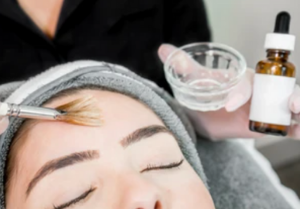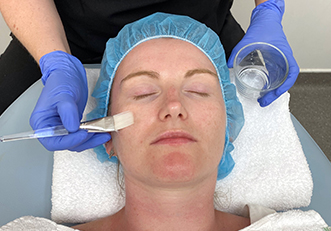
 WHEN YOU SPEND OVER $150(Afterpay not offered on cosmetic nurse treatments)
WHEN YOU SPEND OVER $150(Afterpay not offered on cosmetic nurse treatments)
 WHEN YOU SPEND OVER $150(Afterpay not offered on cosmetic nurse treatments)
WHEN YOU SPEND OVER $150(Afterpay not offered on cosmetic nurse treatments)

Written by Roisin Mc Dermott , Educator and Dermal Therapist for the Australasian Academy of Cosmetic Dermal Science
Salicylic acid is a beta-hydroxy acid (BHA), a compound that encourages the skin to carry out its own exfoliation process. BHA, or salicylic acid, is often mentioned in the same breath as Alpha Hydroxy Acids (AHAs) - for example, glycolic acid. The difference between them lies in the penetration and effect which these acids have on the skin. AHAs are water-soluble, so are more suited towards skin that isn’t very oily and can-do things like brighten and improve skin texture, while improving skin hydration.
BHA/Salicylic acid - is lipid (or oil) soluble, which means that it can cut through the sebum, or oil, which your skin naturally produces - or, problematically, may overproduce. Salicylic acid can penetrate through the stratum corneum (the outer layer of your skin), which is the section that locks moisture in and keeps irritants out. Salicylic acid works to exfoliate your skin, by penetrating your pores and clearing them of blockages, whether these occur in the form of excess oil, dead skin cells, makeup residue or pollution.
Both AHAs and BHA are chemical exfoliants, and work to prompt skin to slough off the dead cells. Salicylic acid is useful when it comes to improving the skin of those among us prone to acne, congestion, or simply an abundance of sebum.
What a great question. If you’re oil-prone, acne-prone, or congestion prone, I’ve probably convinced you. If you’re not, salicylic still might be the ingredient for you. It can work on any lumps and bumps in the skin, even if you don’t identify as acned or congested. It’s particularly effective on keratosis pilaris, which you might know more colloquially as ‘chicken skin’. Salicylic acid is a good option for going about reducing the typical back-of-arm or top-of-leg bumps associated with KP.
The outermost layer of your skin (the stratum corneum) is composed of keratinised skin cells, which protects the layers underneath from the elements and the outside world. When we exfoliate, we slough these keratinised cells off prematurely, before their expiration date (they only remain for four to six weeks undisturbed in any case). This brings the smooth skin to the fore, which looks great - but if we do it too often, or without appropriate care, we’re risking skin sensitisation. Mechanical exfoliation is really a short-term fix, with a placebo effect. It can also cause micro-tears in our skin, which our skin to become irritated more easily.
Over the counter, 2% is all that you will be able to get but don’t underestimate the potency - it’s powerful stuff. If you’re booking in for a salicylic facial peel, the strength of the solution could be 10%, 20% 30%, or even 50%, depending on your peel-provider and your skin conditions. Salicylic acid has been well documented as a successful chemical in providing results driven skincare and treatments and has been in use for at least 2,000 years.
There are many salicylic acid cleansers, exfoliators and serums available and that we recommend and that we love at aacds student clinic.
This lightweight foaming cleanser helps improve surface shine, remove impurities and unclog pores. This cleanser hydrates and conditions skin leaving it deeply clarified and perfectly balanced.
Refines the appearance of large pores, smooths skin's texture and improves overall skin luminosity and radiance.
Retexturizes and helps clarify skin. Contains BHA, AHA and Niacinamide, we love this product as it comes in Mild and higher strength concentrate so it covers all skin types and needs.
At Aspire training clinics we offer Jessner’s peels, which are superficial peels. One of the main ingredients is salicylic acid that deeply penetrates the pores to help remove congested sebum and dead skin cells. Jessner’s peels are ideal for those with oily skin and associated conditions. This peel will visually retexture thickened or oily skin, improve the appearance of enlarged pores, pigmentation and exfoliate the skin’s upper layer, allowing improved absorption of active skin products. Optimum results are usually achieved with three, fortnightly or monthly sessions.

Salicylic acid is not for everyone at all times of their lives. Particularly, it’s not recommended for pregnant women, or for children (although, with careful guidance, it’s suitable for use from 12 upwards). It’s also not recommended for anyone with very sensitive skin, as it can be a bit too harsh for them.
Salicylates, from which salicylic acid and aspirin, are derived can be found all around us. From almonds to willow bark, you’ve been surrounded by it all along.
If you’re interested in studying cosmetic dermal science to become a qualified Dermal Therapist or a qualified Cosmetic Chemist, the Australasian Academy of Cosmetic Dermal Science have two accredited qualifications that will open the door to your new career…
Advanced Diploma of Cosmetic Dermal Science
Diploma of Personal Care Formulation
For further information, click on the above links and/or email enquiries@aacds.edu.au